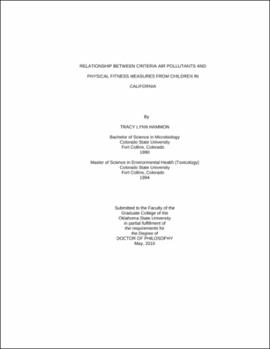| dc.contributor.advisor | Sanders, Dee Ann | |
| dc.contributor.author | Hammon, Tracy Lynn | |
| dc.date.accessioned | 2013-11-26T08:29:49Z | |
| dc.date.available | 2013-11-26T08:29:49Z | |
| dc.date.issued | 2010-05 | |
| dc.identifier.uri | https://hdl.handle.net/11244/7105 | |
| dc.description.abstract | Scope and Method of Study: | |
| dc.description.abstract | This study focused on publicly available data from aerobic capacity and body composition testing in school children during 2006 and 2007 and assessed the relationship between physical fitness rates in California schools and those criteria pollutants that were identified as being in non-attainment during this time period. Fitness data were adjusted for several demographic variables that may influence overall physical fitness. A series of t-tests were conducted to determine if physical fitness differs between attainment and non-attainment areas. Both t-tests and one-way ANOVA were used to identify explanatory variables. Multivariate regression models were used to evaluate the strength of the association between fitness achievement and attainment status after controlling for demographic variables such as gender, socioeconomic status, grade, and ethnicity. For those pollutants that were found to be significant after controlling for demographic variables, additional analyses were performed to determine if a dose-response type relationship exists. | |
| dc.description.abstract | Findings and Conclusions: | |
| dc.description.abstract | Decreases in athletic performance and increased body fat levels in children could be predictive of the potential for adult illnesses. The results of this study suggest that certain criteria air pollutants may adversely influence the physical fitness of children. When properly adjusted for a number of associated confounders, the results of this study support the hypothesis that increases in ambient air pollutant concentrations are associated with decreased aerobic capacity and increased body fat in California schoolchildren. Schools located in non-attainment counties for carbon monoxide, 8-hour ozone, and PM 10 had lower percentages of children passing aerobic capacity fitness testing than did schools located in attainment counties. PM 2.5 attainment status was not significantly associated with aerobic capacity passing rates. Passing rates for body composition testing were lower in schools located in non-attainment zones for all criteria air pollutants (CO, 8-hour O3, PM 10 , PM 2.5 ) evaluated in this study. Although the study design does not allow for causal determination of this relationship, further evaluation showed that a significant dose-response type relationship with aerobic capacity passing rates was present for 8-hour ozone. This association was found for both the number of days that 8-hour ozone concentrations exceeded the NAAQS in the year preceding fitness testing and the annual average concentration of ozone in the year preceding fitness testing. No dose-response type relationship was observed for aerobic capacity passing rates with varying levels of PM 10. | |
| dc.description.abstract | This study found that gender, grade, socioeconomic status, and ethnicity were significantly associated with both aerobic capacity and body composition passing rates. Body fat was also a significant factor for aerobic capacity passing rates. These variables, with the exception of ethnicity, each contributed more to the explanation of variance in the multiple regression models than did the attainment status of the criteria air pollutants that were evaluated. | |
| dc.format | application/pdf | |
| dc.language | en_US | |
| dc.rights | Copyright is held by the author who has granted the Oklahoma State University Library the non-exclusive right to share this material in its institutional repository. Contact Digital Library Services at lib-dls@okstate.edu or 405-744-9161 for the permission policy on the use, reproduction or distribution of this material. | |
| dc.title | Relationship between criteria air pollutants and physical fitness measures from children in California | |
| dc.contributor.committeeMember | Ede, Kenneth | |
| dc.contributor.committeeMember | Ketterer, Stan | |
| dc.contributor.committeeMember | Phillips, Brenda | |
| osu.filename | Hammon_okstate_0664D_10777.pdf | |
| osu.accesstype | Open Access | |
| dc.type.genre | Dissertation | |
| dc.type.material | Text | |
| dc.subject.keywords | aerobic capacity | |
| dc.subject.keywords | body fat | |
| dc.subject.keywords | california | |
| dc.subject.keywords | children | |
| dc.subject.keywords | criteria air pollutants | |
| dc.subject.keywords | physical fitness | |
| thesis.degree.discipline | Environmental Science | |
| thesis.degree.grantor | Oklahoma State University | |
